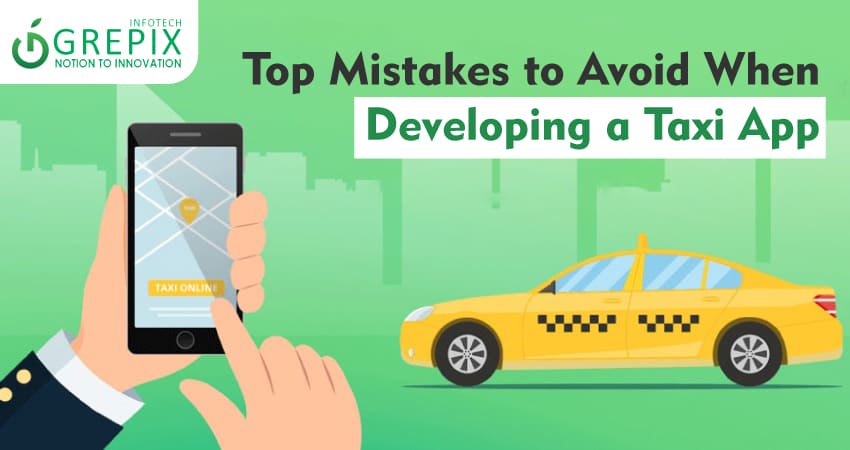Top Mistakes to Avoid When Developing a Taxi App
Developing a taxi app can be an exciting yet challenging journey, especially with the promise of tapping into the global demand for convenient ride-hailing services. However, many developers face pitfalls during the development process, some of which can significantly impact app performance, user experience, and profitability. Below is an in-depth exploration of the top mistakes to avoid when developing a taxi app, aiming to guide you toward creating a successful, competitive product.
Developing a taxi app is a promising yet complex endeavor, as it involves catering to global demands for convenient, reliable ride-hailing services. To create a successful and competitive product, developers must avoid common mistakes, such as neglecting market research, overlooking user experience, and underestimating security needs. Each step, from thorough audience analysis to robust GPS integration and scalable infrastructure, is crucial for a seamless user experience. Grepix Infotech brings industry expertise to this process, ensuring optimized, secure, and user-friendly apps that thrive in competitive markets. With Grepix, you can turn development challenges into opportunities for business growth and customer satisfaction.
1 Neglecting Market Research and Target Audience Analysis
One of the biggest mistakes developers make is jumping into the development phase without adequate market research. Market research helps identify trends, user preferences, regional requirements, competitor offerings, and potential challenges.
- Why it’s crucial: Each market has unique needs and regulatory framework. For example, developing a taxi app for a bustling city like New York might require different functionalities than in a rural area. Failing to consider these specifics can lead to an app that misses the mark entirely.
- Solution: Conduct thorough market research and audience analysis before development. Identify key demographics, competitor apps, user preferences, and cultural considerations. This knowledge will assist you in developing an app that appeals to your intended user base.
2Inadequate Budget Planning
Budget constraints are a significant factor in app development, but underestimating or mismanaging the budget can lead to shortcuts that compromise the app’s quality.
- Why it’s crucial: Developers often overlook hidden costs such as app maintenance, marketing, and future upgrades. As a result, they end up with a subpar product due to insufficient resources.
- Solution: Establish a realistic budget, including costs for development, maintenance, updates, and marketing. Aim for future app scalability and set aside money for unforeseen costs.
3Overlooking User Experience (UX) Design
A poorly designed user interface can frustrate users, leading to poor engagement and retention. Taxi apps need to prioritize intuitive and seamless design.
- Why it’s crucial: Users expect a quick and easy experience. A cluttered or complicated interface will deter users from using the app, especially if they need an urgent ride.
- Solution: Ensure that the app’s UX design is user-centric. Make sure that core functionalities like booking a ride, tracking, and payment are easily accessible and simple to navigate. User testing and feedback collection can provide valuable insights for improvement.
4Ignoring Platform Optimization
Developers sometimes launch apps optimized only for one platform, often ignoring the nuances of other platforms.
- Why it’s crucial: Each platform (iOS, Android, etc.) has different design guidelines, user expectations, and performance benchmarks. Ignoring these differences may lead to suboptimal app performance on certain platforms, affecting user experience and retention.
- Solution: Ensure platform optimization for each operating system. Develop native versions for iOS and Android, or use cross-platform frameworks to create a unified experience while respecting platform-specific guidelines.
5Inadequate GPS Accuracy and Navigation Features
GPS is the backbone of any taxi app. Inaccurate location tracking or slow updates can lead to user frustration.
- Why it’s crucial: Location accuracy affects driver availability, ETA, route efficiency, and overall user satisfaction. Users are quick to abandon apps that fail to provide reliable location-based services.
- Solution: Invest in a robust GPS module and ensure your app supports real-time tracking and accurate location data. Regularly test and update your GPS and mapping functionalities, particularly in regions with poor connectivity.
6Compromising on Security
Security is paramount, particularly when handling sensitive data like payment details, contact information, and location history.
- Why it’s crucial: A single data breach can damage your app’s reputation and result in regulatory penalties. Users trust that their personal information is safe with the app, and a failure to secure data can lead to significant losses.
- Solution: Implement strong encryption protocols, secure payment gateways, and data privacy policies. Regularly conduct security audits and vulnerability assessments to identify and fix potential security gaps.
Also Read: "How Taxi Apps are Changing the Face of Urban Mobility"
7 Failing to Integrate Payment Flexibility
Payment flexibility is critical in enhancing user convenience. However, some developers limit their apps to only one or two payment options, which can be inconvenient for users.
- Why it’s crucial: Different users prefer different payment methods, including credit cards, digital wallets, cash, or in-app payments. Limited options can alienate potential users.
- Solution: Incorporate multiple payment options, including popular digital wallets, credit cards, and cash payments. Ensure the integration of a reliable, secure payment gateway to facilitate these options.
8Lack of Comprehensive Driver and User Management System
Developers often focus too much on user functionalities while neglecting the driver management system.
- Why it’s crucial: The app's success relies on a smooth interaction between drivers and users. Without a comprehensive driver management system, it’s challenging to monitor driver performance, allocate rides efficiently, and ensure quality service.
- Solution: Create a robust backend for effective driver management, including rating systems, feedback channels, and performance monitoring. Make it easy for drivers to manage their accounts, view earnings, and access customer support.
9Underestimating the Importance of Analytics
Analytics often go overlooked, yet they’re crucial for understanding user behavior and making data-driven improvements.
- Why it’s crucial: Analytics help identify patterns, such as popular routes, peak booking times, and areas with high demand. Ignoring analytics means missing insights that could enhance user experience, optimize operations, and increase profitability.
- Solution: Integrate analytics tools from the beginning. Track key performance indicators (KPIs) such as user engagement, booking frequency, ride duration, and retention rates. Use these insights to make data-driven decisions that benefit both users and drivers.
10Poor Marketing and User Acquisition Strategy
A well-designed app is of little use if people don’t know about it. Many developers neglect marketing efforts, assuming a good product will naturally attract users.
- Why it’s crucial: A competitive industry like taxi services requires proactive marketing to attract users. Without it, you may struggle to grow your user base and achieve profitability.
- Solution: Develop a targeted marketing strategy that includes social media campaigns, influencer partnerships, and in-app referral programs. Leverage app store optimization (ASO) to increase visibility and encourage user reviews to build credibility.
11Not Prioritizing Customer Support
Users and drivers alike need a reliable support system to address issues as they arise. A lack of customer support can frustrate users, leading them to abandon the app.
- Why it’s crucial: Quick problem resolution can significantly enhance user satisfaction and loyalty. Conversely, poor customer service can lead to negative reviews and reduced retention.
- Solution: Create a customer support system that is responsive and offers a variety of channels, such as phone, email, and in-app chat. For faster resolution, consider adding an FAQ section and a support bot for common queries.
12Skipping Beta Testing and User Feedback
Skipping beta testing is a common yet avoidable mistake. User feedback during beta testing provides invaluable insights that can help fine-tune the app before launch.
- Why it’s crucial: Developers often overlook minor bugs and issues during internal testing, which can lead to crashes and bugs in the live version. User feedback is essential for detecting usability issues that may have been missed in development.
- Solution: Conduct a beta test with a diverse group of users, including both drivers and passengers. Encourage them to provide feedback on usability, performance, and design. Use this feedback to make improvements before the official launch.
13Neglecting App Maintenance and Updates
The journey doesn’t end after the app launch. Continuous updates and maintenance are necessary to keep the app functional, secure, and relevant to evolving user needs.
- Why it’s crucial: Regular updates ensure bug fixes, security patches, and compatibility with the latest operating systems. Neglecting maintenance can lead to crashes, security vulnerabilities, and a decline in user satisfaction.
- Solution: Schedule regular updates and bug fixes. Listen to user feedback, keep up with technological advancements, and incorporate new features based on user demand. Over time, this will support sustaining user satisfaction and engagement.
14Not Focusing on Scalability
Scalability is often neglected, particularly in the early stages. However, as the user base grows, an app must handle increased demand without compromising performance.
- Why it’s crucial: A scalable app architecture is crucial to handling growth. If the app can’t manage increased traffic and users, it will lead to slower response times and potentially a loss of users.
- Solution: Design the app with scalability in mind from the beginning. Use cloud-based infrastructure and modular architecture to handle increased traffic, integrate load balancing, and ensure that servers can be scaled up or down as needed.
15Mismanagement of Push Notifications
Push notifications can be a powerful tool to engage users. However, excessive or irrelevant notifications can lead users to disable them or even uninstall the app.
- Why it’s crucial: Users expect relevant and timely notifications. Spamming or irrelevant messages can frustrate users, resulting in poor retention and engagement rates.
- Solution: Implement a user-friendly notification system that allows users to customize their notification preferences. Focus on sending notifications that add value, like trip confirmations, driver arrivals, and exclusive discounts.
16Ignoring Multilingual and Multi-Currency Support
If your taxi app is intended for global or multi-regional use, failing to incorporate multiple languages and currencies is a critical oversight.
- Why it’s crucial: Users prefer apps that cater to their language and currency preferences. Failing to provide these options can alienate a significant portion of your potential user base.
- Solution: Include multi-language and multi-currency support, especially for regions with diverse populations or where multiple currencies are commonly used. This small step can significantly enhance user experience and broaden your reach.
Conclusion
Developing a taxi app requires not only technical expertise but also strategic foresight, user-centric design, and continuous improvement. Avoiding these common pitfalls will help create a competitive app that meets the needs of both drivers and passengers. Grepix Infotech brings extensive experience and a deep understanding of the ride-hailing industry, ensuring that each stage of development from market research to platform optimization and scalability aligns with the unique requirements of the market. By leveraging Grepix’s expertise, you can avoid the usual mistakes, focus on delivering an intuitive and reliable app, and ultimately build a product that enhances user satisfaction and drives business success. Let Grepix Infotech be your partner in navigating the complexities of taxi app development, creating a solution that stands out in today’s competitive landscape.
Looking out to start your own venture like Uber? Try out our HireMe Taxi Uber Clone, the easiest way to kick-start your taxi business.







